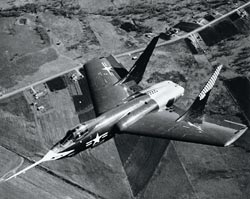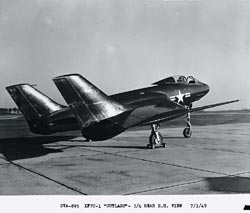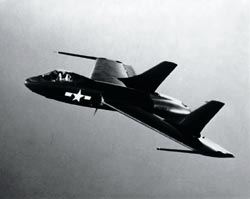|
A Different Fighter
 In mid 1945, Vought responded to a Navy Request for Bid on a 600-mile-per-hour fighter capable of 40,000 feet altitude and configured to a unique design. It was very innovative in that it had a swept wing and no horizontal tail. The horizontal tail was eliminated to avoid extreme nose down forces experienced by other airplanes of the day at speeds above Mach 0.75. The swept wing had “ailevator” control surfaces far out on the wing trailing edge beyond the vertical fin mid-mounted on each wing. These surfaces served as both elevator (pitch) controls and aileron (roll) controls. The airplane was designed for Mach 0.9 (plus) speed up to at least 40,000 feet altitude. In mid 1945, Vought responded to a Navy Request for Bid on a 600-mile-per-hour fighter capable of 40,000 feet altitude and configured to a unique design. It was very innovative in that it had a swept wing and no horizontal tail. The horizontal tail was eliminated to avoid extreme nose down forces experienced by other airplanes of the day at speeds above Mach 0.75. The swept wing had “ailevator” control surfaces far out on the wing trailing edge beyond the vertical fin mid-mounted on each wing. These surfaces served as both elevator (pitch) controls and aileron (roll) controls. The airplane was designed for Mach 0.9 (plus) speed up to at least 40,000 feet altitude.
 Upon Navy go-ahead for three experimental airplanes, Vought designed and built them at the Stratford, Connecticut Plant. The airplane was designed for U. S. Navy carrier operations, weighed 14,300 pounds and was powered by two Westinghouse XJ34-WE-32 afterburner-equipped turbojet engines. The armament was four 20-mm cannons. The wings folded just outboard of the vertical fins for storage (spotting) on the carrier deck. Leading edge slats were provided on the wings for higher lift at low speeds to enhance carrier landing characteristics. The aircraft had tricycle landing gear with the two main gears stowed in flight in the lower fin structure. Upon Navy go-ahead for three experimental airplanes, Vought designed and built them at the Stratford, Connecticut Plant. The airplane was designed for U. S. Navy carrier operations, weighed 14,300 pounds and was powered by two Westinghouse XJ34-WE-32 afterburner-equipped turbojet engines. The armament was four 20-mm cannons. The wings folded just outboard of the vertical fins for storage (spotting) on the carrier deck. Leading edge slats were provided on the wings for higher lift at low speeds to enhance carrier landing characteristics. The aircraft had tricycle landing gear with the two main gears stowed in flight in the lower fin structure.
 The first X7FU-1 was barged to Patuxent River Test Center and first flown 29 September 1948 by Vought Test Pilot Robert Baker. This airplane and the #2 and #3 airplanes were all test flown at Patuxent River by company and U. S. Navy pilots and were flown without afterburners until they became available from Solar in late 1949. Continued testing in 1950 and 1951 was conducted to further evaluate the aircraft for carrier use. The first X7FU-1 was barged to Patuxent River Test Center and first flown 29 September 1948 by Vought Test Pilot Robert Baker. This airplane and the #2 and #3 airplanes were all test flown at Patuxent River by company and U. S. Navy pilots and were flown without afterburners until they became available from Solar in late 1949. Continued testing in 1950 and 1951 was conducted to further evaluate the aircraft for carrier use.
The unconventional aircraft configuration required much development testing. The landing gear required experimentation to determine best extended positions for landing and take-off. The pressurized cockpit, pilot visibility, and pilot instruments needed evaluation. Aerodynamic performance had to be evaluated at all speeds and altitudes to determine suitability for the design fighter task.
Unfortunately, over the two years of XF7U-1 flight testing, all three airplanes were lost in accidents. The #2 airplane was lost in Chesapeake Bay with pilot William Millar. Pilot Paul Thayer survived a take-off crash of #1 and an engine fire ejection seat escape from #3 airplane.
|